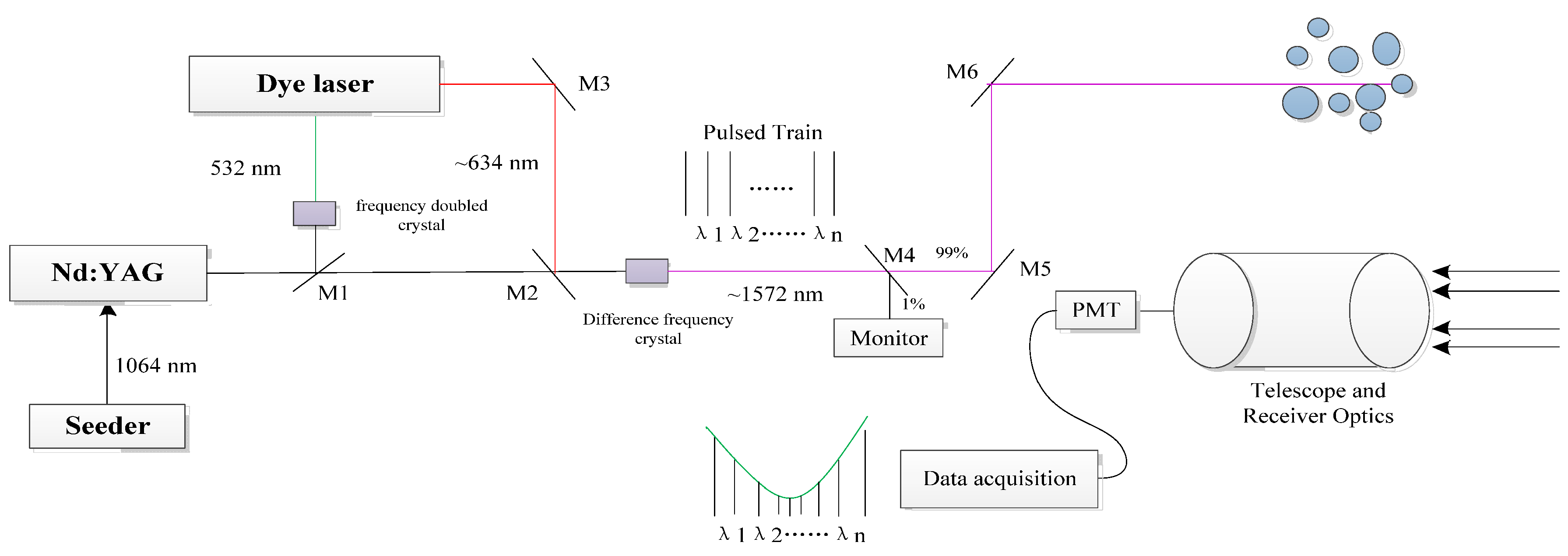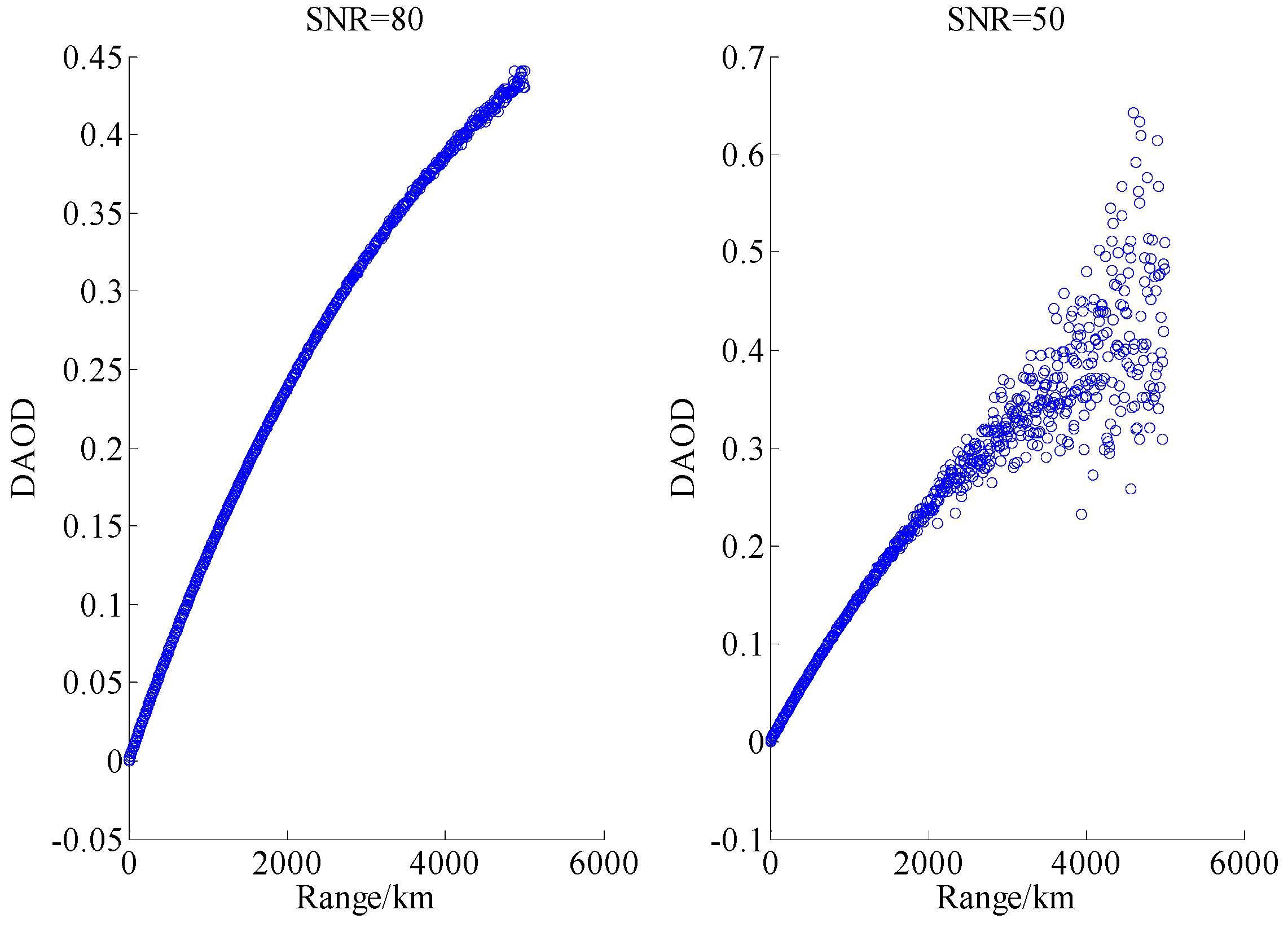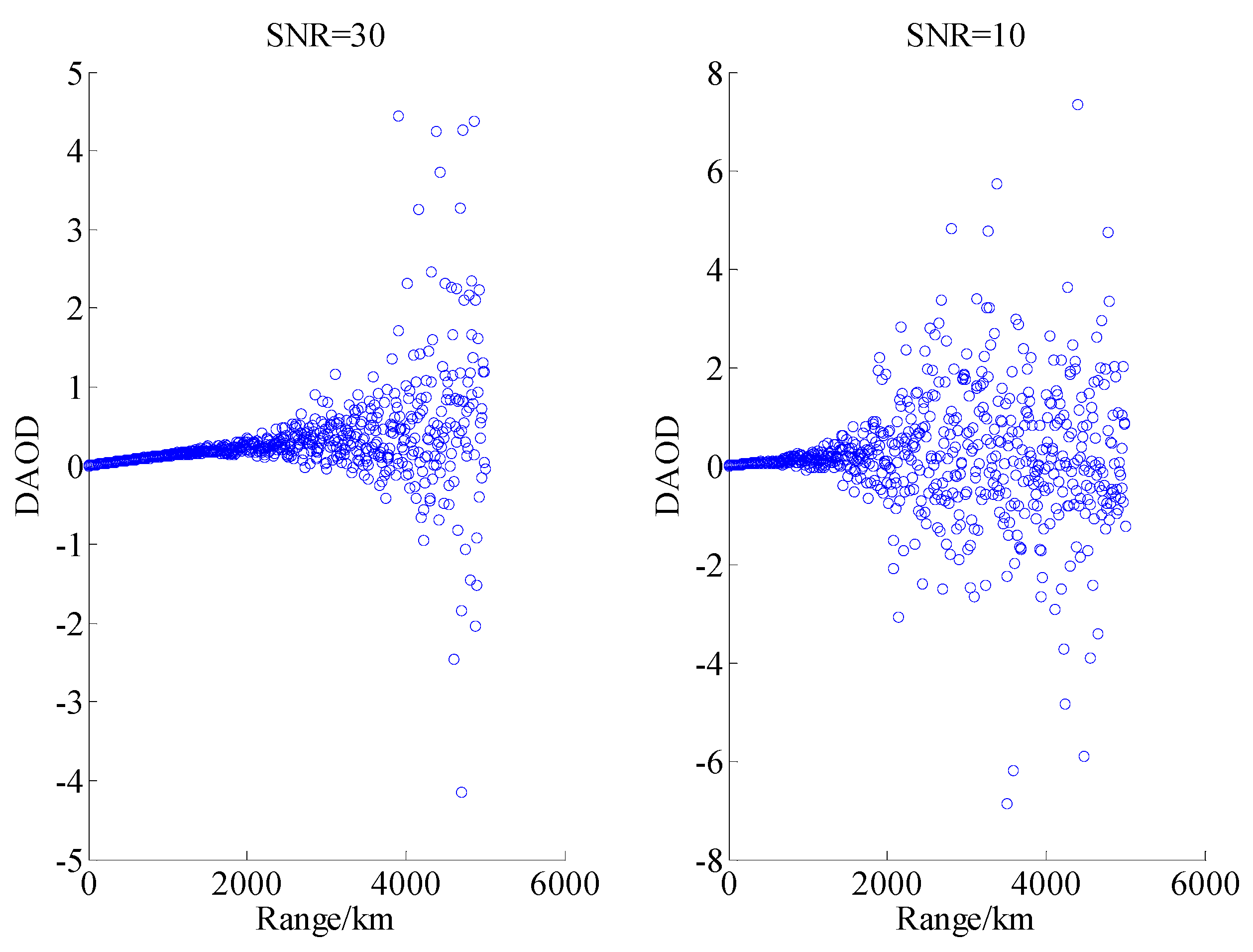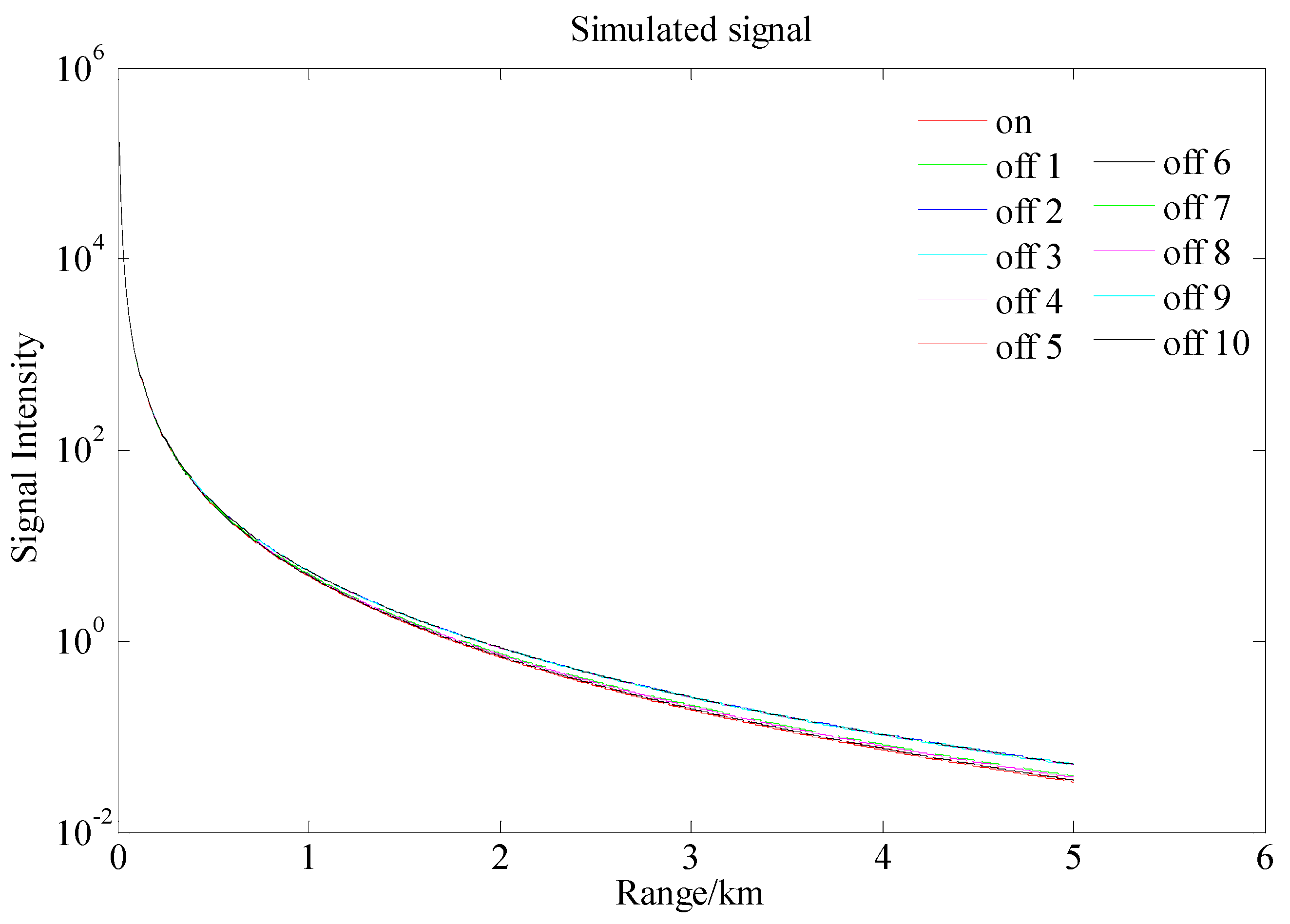To evaluate the feasibility and accuracy of MW-DIAL for atmospheric CO
2 detection, we conducted a series of simulated experiments. Most spectroscopic parameters of CO
2 lines for the simulation analysis were obtained from Predoi-Cross et al. [
28] and HITRAN 2012 [
29]. The spectroscopic parameters of the absorption lines of H
2O were obtained from HITEMP 2010 [
30,
31]. According to the HITRAN 2012 molecular spectroscopic database, six absorption lines in the range of the 30012–00001 carbon-dioxide band were studied because their intensities were evidently higher than those of others. The spectroscopic parameters of the absorption lines of CO
2, which are marked as C1–C6 (namely, R10–R20), and those of H
2O in this range are listed in
Table 1. The absorption lines are also presented in
Figure 2, with the absorption cross sections of the H
2O and CO
2 molecules at 101325 Pa and 296 K calculated using the Voigt profile. In spectroscopy, the Voigt profile is a line profile that results from the convolution of two broadening mechanisms. One of the broadening mechanisms produces a Gaussian profile as a result of the Doppler broadening; the other produces a Lorentz profile. Because of its physical implications, the Voigt function is superior to other functions for obtaining the absorption line of CO
2 [
25]. The H
2O curve, which marks the right axis, is on a log scale, given that the intensities of the lines are much smaller than those of CO
2. H1–H13 were not labeled because our concern was their effects on CO
2. In selecting the operating wavelength, we had to consider many factors, such as low temperature sensitivity and low interference from other molecules. Previous studies showed that H
2O is the most critical interference molecule in the absorption spectroscopy of CO
2 [
31,
32]. As shown in
Figure 2, R10, R12, and R20 are inappropriate because they are considerably affected by interferences from H
2O. R16 is the most appropriate because the intensity of this peak is the strongest, and the influence of H
2O in this band is less than that in R14 and R18. Consequently, less noise is generated, and the differential optical depth is the largest. Thus, R16 has the highest SNR in this range and is recommended for measuring atmospheric CO
2 using DIAL at 1572 nm.
4.1. Simulation Analysis of Wavelength Shift
The simulation analysis of wavelength shift was conducted in three parts. The first part concerned theoretical inversion, in which both the parameters of on-line and off-line wavelengths were theoretical values. Results of this inversion were supposed to be 400 ppm, which is marked as C0 and used as the evaluation criterion for inversion. The logarithm of the energy ratio (i.e., DAOD) of on-line and off-line wavelengths was obtained using Equations (2) and (3). The DAOD was used for inversion in the second and third parts, which were both under the conditions of lasers with shifting wavelengths. The methods of inversion for the last two parts were DW-DIAL and MW-DIAL, respectively. The inversion results are marked as C1 and C2. Finally, C0, C1, and C2 were compared to obtain the inversion accuracy of CO2 using the different methods.
4.1.1. Part 1
As shown in
Figure 3, in the section of the on-line and off-line wavelengths in the region of R16, the on-line wavelength could be easily obtained because only one absorption peak of CO
2 was observed in the region of R16, which is marked as 2. The theoretical wavelength of point 2 was 6359.962 cm
−1. However, two absorption valleys of CO
2 were found on both sides of the on-line wavelength, which are marked as 1 and 3, respectively. According to the spectroscopic parameters of the CO
2 lines from HITRAN 2012, the intensity of Point 1 was lower than that of Point 3, but Point 1 was largely affected by the water vapor. The intensity of water vapor at Point 1 was approximately 8.9162 × 10
−28 whereas that at Point 3 was 5.4435 × 10
−28. Consequently, Point 3 was considered to be the position of the off-line wavelength, and its wavelength was 6360.609 cm
−1.
According to
Section 2, the DAOD of the on-line and off-line wavelengths could be easily obtained through the DW-DIAL: supposing that
r1 = 0,
r2 = 50,
P(λ
on,
r1) =
P(λ
off,
r1) = 4 mJ, C
0 = 400 ppm. In addition, σ
g(λ
on) and σ
g(λ
off) could be obtained from HITRAN 2012, which were 7.1785 × 10
−23 and 2.2250 × 10
−24 cm
2, respectively. Then, N
0 = 1.0747 × 10
22, and
= 7.476 × 10
−3 for the on-line and off-line wavelengths of DW-DIAL based on Equations (2) and (3).
In the system of MW-DIAL, the number and position of multiple wavelengths were various and could be adjusted according to the situation. The general concept here is that all points are distributed on both sides of the absorption peak. Points close to the absorption peak are relatively dense, whereas those away from the absorption peak are sparse. In this study, 11 points were selected for the simulated experiments using MW-DIAL. Their positions are shown in
Figure 4.
The calculation of DAOD for MW-DIAL is similar to that for DW-DIAL. In this study, the points distributed on both sides of the absorption peak were regarded as the off-line wavelengths and used in the difference processing with the on-line wavelength. DAODs of the on-line and each off-line wavelength were obtained according to Equations (2) and (3), which are listed in
Table 2.
4.1.2. Part 2
Part 2 involved the analysis of inversion through DW-DIAL under the condition of lasers with shifting wavelengths. Supposing that the shift of on-line and off-line wavelengths was 1 pm, which is approximately 0.004 cm
−1 in the region of R16, the absorption cross sections of on-line and off-line wavelengths became σ
g(λ
on) = 7.1785 × 10
−23cm
2 and σ
g(λ
off) = 2.2250 × 10
−24cm
2 from HITRAN 2012. However, they were still considered to be located at the absorption peak and valley, and their original values were used in the inversion. Accordingly, an error result in the inversion was produced. The inversion errors of different shifts of wavelength in the DW-DIAL are listed in
Table 3. The shifts of on-line and off-line wavelengths were 1, 2, 3, 7, and 9 pm, respectively. Note from
Table 3 that the inversion error increases rapidly as the shift of on-line and off-line wavelengths increases. In addition, the errors caused by wavelength shift in the left direction are greater than those in the right direction. This is probably because of the difference between the left and right parts of the CO
2 absorption line.
4.1.3. Part 3
Part 3 involved an analysis of inversion through MW-DIAL under the condition of lasers with shifting wavelengths. This analysis processing was similar to that in Part 2. Supposing a shift of on-line and off-line wavelengths occurred in the region of R16, causing a change in the absorption cross sections of multiple wavelengths. However, they were still considered to be located at the original positions, and their original values were used in the inversion. Accordingly, an error in the inversion was produced.
Given the many points that participate in the inversion, all parameters of the points are not listed. For Part 3 of the simulation, a list of only the final inversion results is shown in
Table 4.
As shown in
Table 3 and
Table 4, given the drifting wavelengths of the laser, the detection accuracy of MW-DIAL for CO
2 was higher than that of DW-DIAL, especially when the drift was large.


















